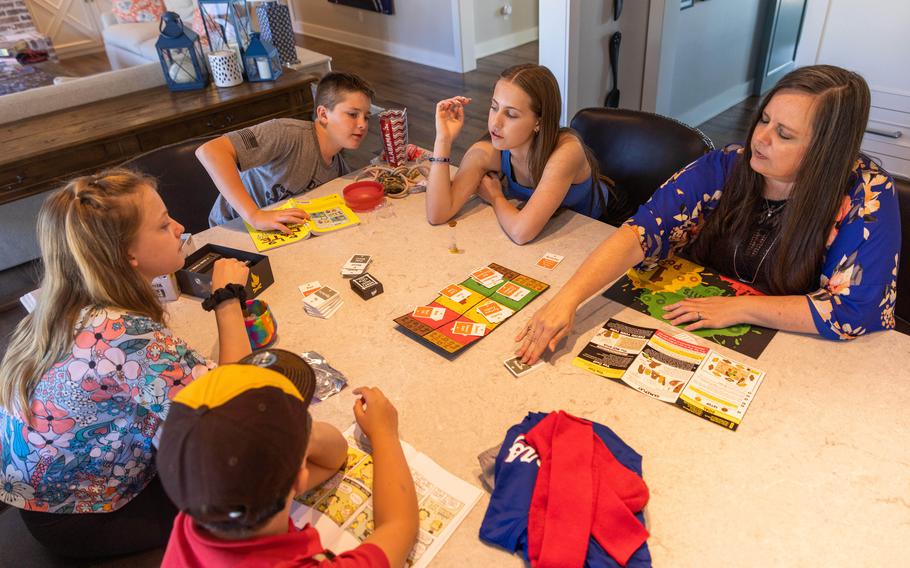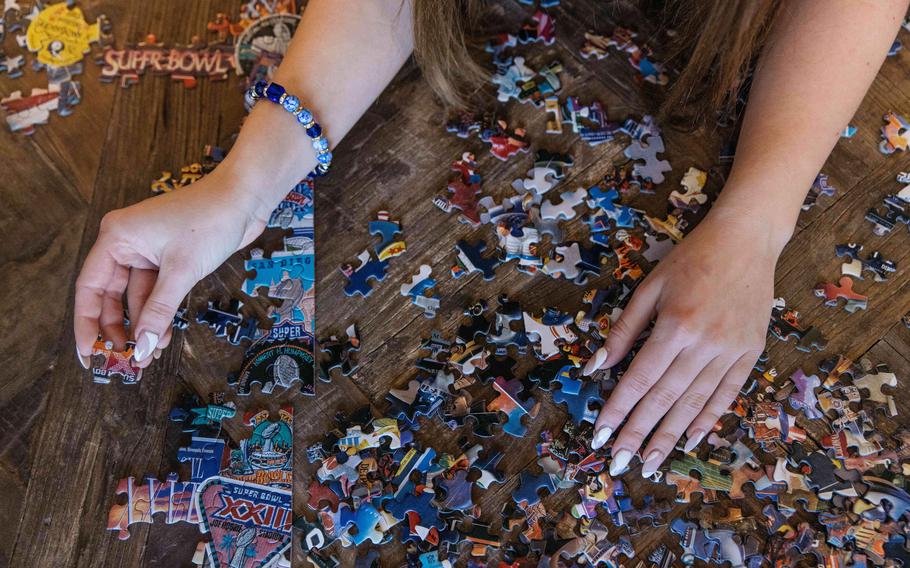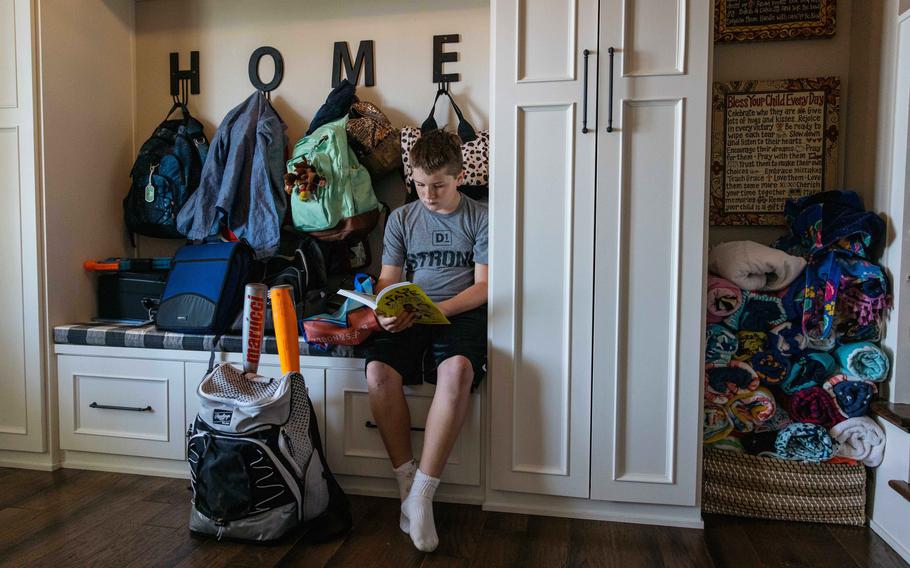
From left, Mary Virginia, Jack, Whitman, Annalise and mother Adriana Stacey play a game at their home in Fayetteville, Ark. (Terra Fondriest/For The Washington Post)
For Adriana Stacey, it’s very simple.
“I’ll never buy a smartphone for any of my children,” she says.
It’s a personal stance born of professional experiences. Stacey is a psychiatrist who works primarily with high school and college students in Fayetteville, Ark., and in her practice she routinely asks new patients to swipe open their phones and show her how much screen time they’re clocking per day.
“I rarely find one that’s under nine hours,” she says. “So, these teenagers are spending more time on their phone than they are sleeping.”
She often urges those patients to delete just one app. Baby steps. But to some young people who land in her office, the thought of not keeping up a Snapchat streak is almost unfathomable.
“I’ve said, ‘We can’t go any further with your treatment until you get your phone use down,’ and they just don’t come back,” she says. “That’s how strong the pull is for these devices.”

Adriana, Jack and Annalise Stacey with their dog, Rosemary. (Terra Fondriest/For The Washington Post)
So Stacey, a mother of four, made a decision: Not her kids.
“If they want one when they turn 18 and they have a job and they can afford it, that’s their choice,” she says.
Stacey is a hard-liner in a war being waged in homes everywhere as grown-ups attempt to limit smartphone use that they believe can be harmful to kids, even as they struggle to establish healthy habits with their own phones. And, big surprise, the parents aren’t winning. Because it’s not just their children they’re up against, but also a tech industry pushing products that insiders say are designed to be addictive and a society that has largely capitulated to the norms, and urges and expectations all those phones and apps have created.
Even when it comes to kids. Fifty-three percent of American children have a smartphone of their own by age 11, according to a 2019 report by Common Sense Media. By the time they’re 16, 89% of kids have one. An earlier report by Common Sense Media found that 50% of teenagers felt addicted to their smartphones and that 59% of their parents thought that was the case. All of this has coincided with a startling increase in mental health challenges among adolescents, which some psychologists believe might be tied to the adverse effects of social media use.
As Stacey sits with young patients who are grappling with anxiety or depression or lack of focus and can’t fathom cutting back their smartphone use, a single thought tends to run through her head: “This is so stupid, that these little devices are controlling these kids.”
The psychiatrist can’t force her patients to give up their smartphones. But she’s making darn sure her own kids don’t have them.
By the end of eighth grade, Annalise Stacey was the only one in her class without a smartphone. And her mom’s spiels about how bad the devices are for kids’ brains didn’t make that much easier.
If her friends decided to hang out after school or on a weekend, they would make plans via group text. When she went to sleepovers, she often ended up watching other girls scroll on their phones. Annalise, who is now 15, sometimes didn’t know what her classmates were talking about because gossip had been exchanged over text or social media.
“I was frustrated just because I’m more of a shy person, so I felt like I was definitely getting left out of things and I didn’t really know how to get included,” she says during a Zoom interview from her room, where gauzy fabric forms a canopy above her bed.
Dance competitions were the worst. In middle school Annalise danced on a competitive team that included girls from different schools. The girls had lots of downtime during competitions while they waited their turn to perform. In another era this might have been an opportunity to chat or goof around. But Annalise was trapped in that era by herself.

Annalise Stacey, right, stretches before a hip-hop dance class. (Terra Fondriest/For The Washington Post)
“I’d try to talk to people, but they’d just kind of go on their phones or on Snapchat or whatever,” she says. Not that she blamed them. They were being social — online, with people they already knew.
Annalise learned to bring a book along to competitions. She’d spend more time stretching on her own. She still loved dance, but the dynamic wasn’t much fun.
“That was one of the reasons I actually quit dance for a year,” Annalise says. “It was hard for me to make friends on the team.”
Adriana Stacey knows how rough it’s been for Annalise.
“It’s sort of a double-edged sword,” she says. “I can see it with my kids and how it affects them and their relationships.”
But she’s convinced that for all the challenges of going without a smartphone in adolescence, the toll of having one would be worse.
For Wendy Herlich’s 13 year-old daughter, Vera, being barred from owning a smartphone means a lot of things, none of them good. First, there’s the practical issues. Vera has been in classes where the teacher asks students to take a photo of the notes with their phones. She can’t do it. At Hebrew school the sessions often begin with a quiz game that requires answering via smartphone. She can’t do it. Sometimes her friends will pity Vera and hand her one of their phones, saying she can borrow it for a little while. She really hates that.
Beyond the practical, Vera feels like not having a smartphone is an indication that her parents don’t trust her. And like they don’t care about her feelings. How could they understand what it means to be 13 and phoneless? Smartphones weren’t even a thing when they were kids.
Vera’s parents do let her have a phone — if you could even call it that. It’s a stripped-down device called a Light Phone that can make calls and send text messages. She’s so embarrassed by it that she almost never brings it out around other kids, especially ones she doesn’t know well.
“It’s, like, really dorky,” she says. “And there’s a lot of kids who judge me. Like I’m someone who’s not responsible enough to have something everyone else has.”
Wendy Herlich does, in fact, care about her daughter’s feelings. The 47-year-old copywriter says she and her husband agonized over the smartphone dilemma. Then Wendy heard about “Wait Until 8th,” a nonprofit that encourages parents to collectively decide to keep smartphones out of their kids’ hands until the last year of middle school so as to limit the effects of obsessive phone use without creating too much isolation. There was no mass movement among Herlich’s parent cohort to sign the pledge, but it sounded like a great idea in theory.
“Part of what makes me uncomfortable with this whole thing is that it just feels like there’s no choice,” says the mother. “Because everyone feels like the world is just going this way.”
Herlich’s philosophical opposition to allowing phones at that age was tested when their family moved from Manhattan to New Jersey mid-pandemic and Vera was forced to start at a new middle school. She would have to make all new friends, and wouldn’t be able to connect with them the way they often connected with each other — through their phones.
“There have definitely been a handful of tearful conversations where she really expresses her frustration” about not being allowed to own a smartphone, Herlich says. “Because she’s the only one.”
Emily Cherkin occasionally quakes with anger when she talks about the impact smartphones have had on kids. She spent 12 years as a seventh-grade English teacher in Seattle. When she started out, in 2003, only a few of her students had flip phones and they often seemed embarrassed about them; owning a phone meant you had overprotective parents. By the time she left the classroom, in 2015, the opposite was true.
Cherkin now works as an activist and coach, part of a burgeoning new field of consultants aiming to help parents who are struggling with the impact of their kids’ excessive screen time.
It’s a hard dilemma for anyone to manage gracefully. Smartphones can expose kids to all kinds of toxic stuff online — cyberbullying, porn, bad information, the mind-warping artifice of social media — and yet the devices are so interwoven with modern life that depriving their kids of one doesn’t even seem like an option.

Annalise Stacey works on a puzzle. (Terra Fondriest/For The Washington Post)
“What really troubles me is that we are giving devices and products and apps that are designed to be addictive to children,” Cherkin says, referring to whistleblower accounts of algorithms devised to maximize user attention. “And then we’re expecting them to self-regulate and getting upset when they do stupid things. Middle school was a safe place, for the most part, for kids to screw up and learn how not to do it again the next time. We’ve just taken away the safety net of messing up without being blasted or shamed across a digital platform.”
For some parents, things have gotten so bad that they don’t call a consultant. They call a doctor.
Smartphone addiction mimics substance-abuse in the way it triggers dopamine responses in the brain, says Bradley Aaron Zicherman, who runs a recovery clinic for adolescents at Stanford Children’s Health.
Zicherman often uses the same techniques, including family therapy sessions and interviews designed to help patients find a motivation to change, in treating both disorders.
“It’s maybe even more challenging than some substance abuse issues,” he says, because technology is so ubiquitous. Unlike drug or alcohol abusers, smartphone addicts have to learn to self-regulate their use, not abandon it entirely. And some of his patients have had unfettered access to screens for most their lives. By the time they show up at his clinic, their habits have hardened.
“A lot of cases I get are cases where parents are afraid to limit screen time because it gets to the point where suicidal claims will be made,” he says.
Since setting up the clinic in 2019, Zicherman says he’s been shocked at the number of patient referrals he got for technology-related behavior.
“Half of my intakes are parents requesting help,” he says, “because they feel like their kid’s screen time is out of control and they don’t know what to do at this point.”
Another problem? Parents aren’t setting much of an example. Some are unwilling to modify their smartphone use.
“If you want your child’s behavior to change,” Zicherman says, “you have to change your own behavior.” That’s why he wishes parents would create smartphone rules for the whole family before the devices become a problem.
Some parents feel almost required to have their smartphones within reach.
“I do everything on my phone,” says Cherie Garcia, a single mother of two who owns a kitchen and bathroom design firm outside of Denver. “I live on my phone.”
Garcia says she needs the device so she can be reachable by clients, but feels the negative impact it has on her life and emotions. She wanted to ensure her sons’ brains weren’t shaped by the same forces while they were still developing. She’d read that Silicon Valley executives didn’t give their kids certain devices, and if the people who invented this stuff didn’t trust it then why should she?
It was an unpopular decision in the family. Garcia’s eldest son, Trevor, remembers missing a few get-togethers with friends because he wasn’t on a group chat. Her mother, Trevor’s grandmother, even tried to skirt Garcia’s rules and buy Trevor a smartphone. (“Don’t you dare!” Garcia remembers telling her.)
Aimée Lykins Lawson and her kids were in it together, at first. But when she realized she was missing messages about school, she reluctantly bought herself a smartphone. Before long she found herself unconsciously scrolling through news apps and reflexively responding to notifications.
“It’s like we’re doing this mass experiment on the human brain,” says Lawson, a French tutor.
Her resistance to letting her two youngest kids, 13-year-old Lucien and 12-year-old Sophia, own smartphones has been complicated by the fact that the family is now temporarily living in Abu Dhabi, where her husband works as a professor. They wanted phones to communicate with their American friends back home, Lawson says, and to connect with other teens in their new neighborhood.
When Lawson’s husband upgraded his smartphone, he gave his old one to Lucien. Lawson remained wary and laid out strict rules about when it could be used. When Lawson caught Lucien checking the phone late one night she took action.
“She chucked it into the pool,” the son recalls. That was the end of that argument.
As for the Staceys, in Fayetteville, Adriana’s 15-year-old daughter, Annalise, has begun to appreciate her mother’s hard-line stance as her younger brother and sister — 12-year-old twins — have aggressively lobbied for smartphones of their own.

Whitman Stacey, younger brother to Annalise Stacey, reads a graphic novel after school. (Terra Fondriest/For The Washington Post)
She has seen her friends agonize over drama that took place through text or social media.
“And I’m kind of glad I’m not a part of it,” Annalise says. “It’s so much extra stress on my life that I don’t need.”
Last year she got a simple device called a Gabb phone that can call and text. And though she knows she’ll get a smartphone someday, she’s glad she’s had so much time without one. It’s made her more outgoing, she thinks. And more aware of how the phones can change people’s behavior. When she’s hanging out with friends, she says, they’ll sometimes spend hours trying to capture a perfect photo for social media.
“They just want to take pretty pictures so everyone on Instagram can see how happy they are,” she says. “And I find it strange because I’m like, ‘Can’t we just enjoy what we’re doing?’”